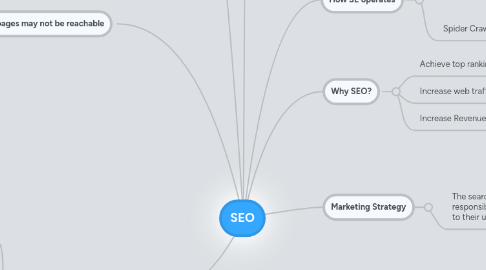
1. How to be listed in SE
1.1. Most important content should be in HTML text format
1.2. Images, Flash files, Java applets, and other non-text content are often ignored or devalued by search engine spiders, despite advances in crawling technology
1.3. Easiest way to ensure that the words and phrases that are display to your visitors are visible to search engines is to place it in the HTML text on the page.
1.4. Double Checking
1.4.1. By using tools like Google's cache, SEO-browser.com, or the MozBar you can see what elements of your content are visible and indexable to the engines
2. Why pages may not be reachable
2.1. Submission-required forms
2.1.1. If you require users to complete an online form before accessing certain content, chances are search engines may never see those protected pages
2.2. Robots don't use search forms
2.2.1. If you require users to complete an online form before accessing certain content, chances are search engines may never see those protected pages
2.3. Links in un-parseable Javascript
2.3.1. Search engines either do not crawl or give very little weight to the links embedded within. Standard HTML links should replace Javascript (or accompany it) on any page where you'd like spiders to crawl.
2.4. Links in flash, java, or other plug-in
2.4.1. Although dozens of pandas are listed and linked to on the Panda page, no spider can reach them through the site's link structure, rendering them invisible to the engines (and un-retrievable by searchers performing a query).
2.5. Links pointing to pages blocked by the meta robots tag or robots.txt
2.5.1. The Meta Robots tag and the Robots.txt file both allow a site owner to restrict spider access to a page
2.6. Frames or I-frames
2.6.1. Present structural issues for the engines in terms of organization and following
2.7. Links on pages with many hundreds or thousands of links
2.7.1. Search engines will only crawl so many links on a given page - not an infinite amount. This loose restriction is necessary to cut down on spam and conserve rankings.
3. Growing popularity and links
3.1. Link Building
3.1.1. "Natural" Editorial Links
3.1.2. Manual "Outreach" Link Building
3.1.3. Self-Created, Non-Editorial
3.2. Link Builing Strategies
3.2.1. Get your customers to link to you
3.2.2. Build a company blog. Make it a valuable, informative and entertaining resource.
3.2.3. Create content that inspires viral sharing and natural linking
3.2.4. Be newsworthy.
3.2.5. Find directories or listings of relevant resources.
3.3. Link Signals
3.3.1. Used by search engines
3.3.2. Global Popularity
3.3.3. Local/Topic-Specific Popularity
3.3.4. Anchor Text
3.3.5. TrustRank
3.3.6. Link Neighborhood
3.3.7. Freshness
3.3.8. Social Sharing
3.4. Using links, engines can not only analyze the popularity of a website & page based on the number and popularity of pages linking to them, but also metrics like trust, spam, and authority. This also can helps the website to generate more traffice if used correctly.
4. keyword research
4.1. how to judge value of keyword
4.1.1. 1)Check whether keyword makes any sense to other users 2)Check for similar website that uses the keyword or else there will be a lot of competition 3)Using of tools such as google adwords is a good way to determine how revlant your keyword is. 4)Using all these data thatyou have collected to calcalulate how much u will be earning over a period of time
4.2. keyword research tools
4.2.1. 1)Google Adwords’ Keyword Tool 2)Google Insights for Search 3)Google Trends Keyword Demand Prediction 4)Microsoft Advertising Intelligence 5)Wordtracker’s Free Basic Keyword Demand
5. How SE operates
5.1. Indexing
5.1.1. It is the search engine index that provides the results for search queries, and pages that are stored within the search engine index that appear on the search engine results page.
5.2. Spider Crawl
5.2.1. The search engines uses a way to crawl through information that is linked to different pages through best path avaliable
6. Why SEO?
6.1. Achieve top ranking
6.2. Increase web traffic
6.3. Increase Revenue
7. Marketing Strategy
7.1. The search engines' primary responsibility is to serve relevant results to their users.
7.1.1. What Users are looking for
7.1.1.1. "Do" Transactional Queries - Action queries such as buy a plane ticket or listen to a song
7.1.1.2. "Know" Informational Queries - When a user seeks information, such as the name of the band or the best restaurant in New York City.
7.1.1.3. "Go" Navigation Queries - Search queries that seek a particular online destination, such as Facebook or the homepage of the NFL.
